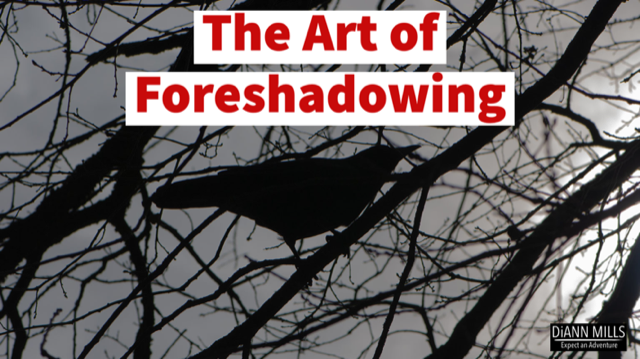
Like a road sign that shows what is ahead, foreshadowing signals tension and suspense while alluding to a fear, threat, humor, tragedy, or specific event—which can be good or bad.
Foreshadowing is an ingenious literary tool that indicates something will happen in the story. It hints or suggests what is to come and becomes a promise to the reader, a promise that must be kept. Like a road sign that shows what is ahead, foreshadowing signals tension and suspense while alluding to a fear, threat, humor, tragedy, or specific event—which can be good or bad. The best foreshadowing uses subtlety and can mislead the character and reader. It doesn’t have to make sense at the time or point to the future.
Foreshadowing falls into one of two categories.
1. Direct: The writer purposely wants the reader to know what will happen to better reveal the story’s happenings. Place this foreshadow in the prologue or first chapter.
2. Indirect: The writer alludes to what will happen, and the reader may not be aware of the foreshadowing until the event occurs.
Writers use various techniques to weave foreshadowing into their stories.
Dialogue offers an opportunity to hint at things to come.
* “I’ve told you repeatedly to stop hanging out with those kids.”
* “Aw, Mom. You’re a teacher. Bill’s dad’s a cop, and Chad’s mom is a judge. How could we get into trouble with parents like that?”
* “For once, I wish you’d stick up for yourself.”
Thoughts are a place to more obviously foreshadow. Rephrase the dialogue above to show how inner thoughts are more promising because the character is reflecting upon wants, needs, desires, and goals.
* Mom had told me repeatedly to stop hanging out with my friends, but she didn’t really know them.
* Our parents were in law enforcement and understood exactly what we might plan, but we thought about it.
* My wife thinks I never stand up for myself.

Symbols use a tangible item to represent something intangible that has a psychological meaning: weather, color, numbers, seasons, various settings, wildlife, memories, hours of the day, and many more. The imagery of the symbol resonates with the character and the reader.
* Winter with its bleak white came early and stayed long past its welcome, much like an unwanted guest.
* I pulled into my driveway, and a black cat walked in front of my car. It stopped and stared at me as if the feline dared me to move one inch ahead.
* She paid for the necklace with the stolen credit card: $666.00.
Emotions pack a powerful punch to show how a character reacts and responds to the surrounding happenings. The seven universal emotions are: surprise, fear, anger, sadness, disgust, happiness, and contempt. Foreshadowing that reaches into the well of a character’s emotion strengthens what is to come.
* Since she was a little girl, she’d climbed the treacherous cliffs rising from the ocean just to see where the horizon met the water. Only those moments took away the loneliness.
* Papa always kept a loaded gun in his nightstand. Not even Mama could touch it.
* The ragged little boy hugged me, but his body odor stopped me from returning any affection.
Expectations for the future show a character’s inner motivation to achieve a goal. In addition, the direct or indirect foreshadowing provides another layer to the plot.
* He looked forward to a two-week summer vacation with nothing tasking him but when and where to fish.
* I planned my life according to logic: finish my masters, begin a career, then look for a husband whose values matched mine.
* Nothing would stop him from earning a law degree. A prestigious law school had accepted him, and he’d secured the funds to pay for it.
In creating a foreshadow, examine the plot and decide where and when the mention should occur. For the outliner, the placement of the technique occurs in the planning stage. For the pantser, the technique’s value may surface after the completion of the first draft.
Other categories such as prophecy, culture, and genre incorporate foreshadowing to enhance the storyline and deepen characterization. Readers may or may not comprehend the technique, and that’s okay. When readers recognize it, they are even more involved in the adventure. The writer has provided a narrow path for the character and the reader to follow.
DiAnn Mills is a bestselling author who believes her readers should expect an adventure. She weaves memorable characters with unpredictable plots to create action-packed, suspense-filled novels. DiAnn believes every breath of life is someone’s story, so why not capture those moments and create a thrilling adventure?
Her titles have appeared on the CBA and ECPA bestseller lists; won two Christy Awards, the Golden Scroll, Inspirational Reader’s Choice, and Carol Awards contests.
